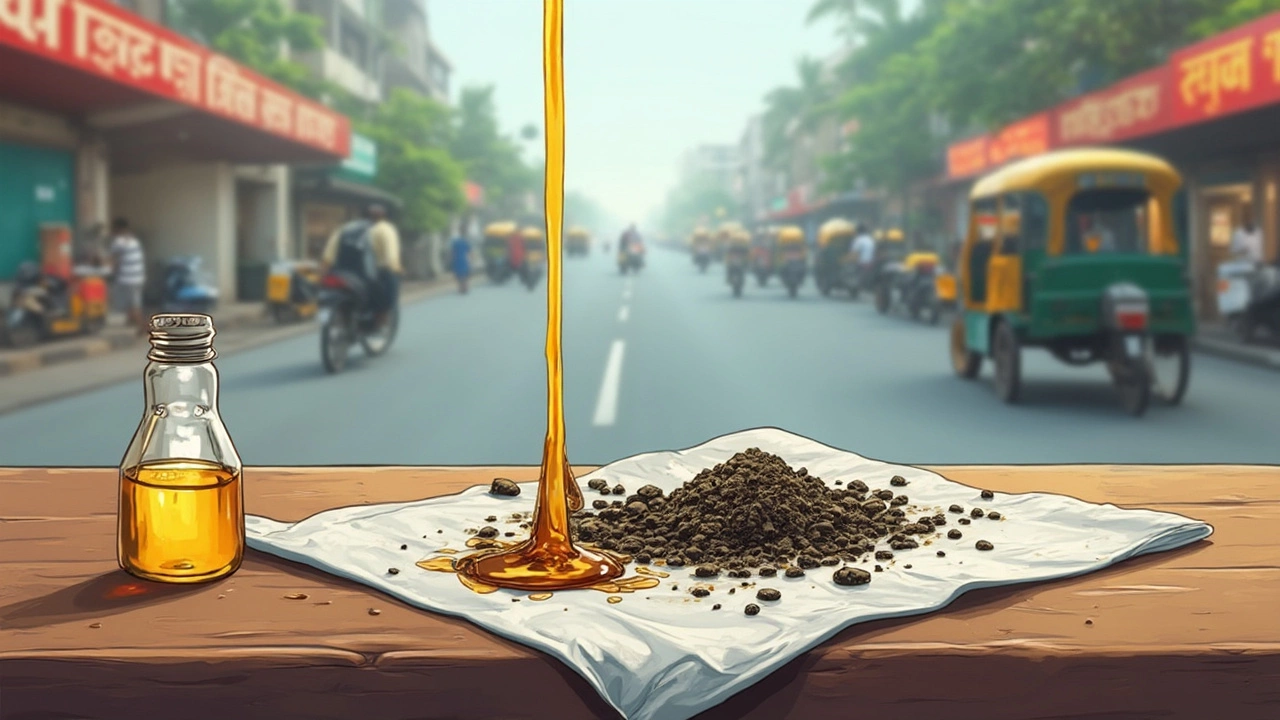Engines aren't picky eaters, but they do care a lot about what’s flowing through their veins. If you’re not sure whether your oil is still up to the job, you're not alone—loads of folks drive longer than they should between changes.
Skip the guesswork. The oil’s color, smell, and feel tell you much more than a sticker from your shop. Know what smooth, amber oil looks like? That's your goal. If what’s on your dipstick is thick, gritty, or pitch black, you might be running on borrowed time.
Don't just rely on miles or time. Sometimes your driving style or environment means your oil wears out faster or slower. Giving that dipstick a quick wipe and peek can save headaches down the road. Let’s get into what those signs really look like, and how you can tell if your oil’s still good—no mechanic required.
- What Fresh Oil Looks and Feels Like
- Simple At-Home Oil Checks
- Red Flags: Signs Your Oil Is Done
- Extra Tips to Stretch Oil Life
What Fresh Oil Looks and Feels Like
Fresh engine oil is easy to spot if you know what to look for. Right out of the bottle, it usually has a smooth, almost slick feeling—not gritty or sticky. As for color, it’s typically golden or amber. If you grab a white paper towel, drop a bit of new oil on it, and hold it up to the light, it should look see-through and clean, not dark or cloudy.
The smell matters too. New oil doesn’t have much of a scent, and what little there is tends to be mild—not burnt or sour. If your oil smells like it’s been through a barbecue, that’s a bad sign. A modern data point: Most new oils (synthetic or conventional) have a base viscosity rating listed on the bottle, such as 5W-30 or 10W-40. This number tells you how thick the oil is at different temperatures—fresh oil should pour easily, like smooth syrup, not honey that’s been in the fridge.
If you’re not sure how your oil stacks up to fresh stuff, check out this quick comparison:
| Fresh Oil | Used or Bad Oil |
|---|---|
| Golden/amber, clear | Dark brown/black, cloudy or gritty |
| Smooth texture, no grit | Sticky, thick, or sand-like feel |
| Mild scent, no burning smell | Burnt, sour, or chemical odor |
Fresh engine oil should feel slick if you rub it between your fingers, without any little particles. If you run into any chunks or a muddy consistency, it’s time for a change, even if the oil isn’t too dark yet. This isn’t just about looks—fresh oil lets your engine stay cooler, clean, and running smooth. If you want to keep your car happy (and avoid expensive engine fixes), knowing what new oil should look like is step one.
Simple At-Home Oil Checks
Don’t overthink it—checking your oil at home is easy, and you don’t need fancy gadgets or a mechanic’s overalls. Most folks can get a pretty clear idea of their oil’s health with just a paper towel and a couple minutes in the driveway.
First off, check your engine oil when your engine is cool or has been off for at least 10 minutes. This gives the oil time to settle, so you get an accurate read.
- Pop your hood and pull out the dipstick. Wipe it clean with a paper towel.
- Reinsert the dipstick all the way, then pull it out again.
- Look at the color—fresh oil should be a clear amber. Dark or black isn’t always bad, but if it’s thick or gritty, your oil is done.
- Rub a drop between your finger and thumb. It should feel slick, not like dirty sludge. Grit means trouble.
- Smell it. If your oil smells burnt, that’s not good news. That usually means it’s been cooking in the engine too long.
Your owner's manual gives you the oil change schedule for your car, but don’t rely on guesses. A Consumer Reports article puts it best:
“Check your oil once a month. Newer engines may last longer, but visual checks are still the best way to catch a problem early.”
Keep an eye on the amount, too. Oil below the minimum mark can lead to engine damage. If you notice a consistent drop in level, you might have a leak or your engine is burning oil.
Here’s a quick reference table for what you might see and what it means:
| Oil Appearance | What It Means |
|---|---|
| Clear amber, smooth | Oil is in good shape |
| Dark, but smooth | Still ok, but watch closely |
| Gritty or sludgy | Time for a change |
| Foamy or milky | Possible coolant leak (get it checked) |
| Burnt smell | Oil overheating, needs changing |
It’s quick. It’s simple. A minute or two with your dipstick can tell you way more than waiting for a dashboard warning light or hitting a certain number of miles. Keep your eyes and nose open—it’s usually all you need to protect your engine oil.

Red Flags: Signs Your Oil Is Done
Your engine oil won’t last forever. It breaks down from heat, dirt, and all the things your engine throws at it while you drive. Catching the warning signs early keeps your car happy and saves you from bigger repair bills down the line.
Here’s what to watch for if you’re wondering whether your oil has called it quits:
- Engine oil is pitch black or gritty—fresh oil is honey colored and smooth, but once it turns dark and feels like sandpaper, it’s time to act.
- There’s a burnt smell when you check your dipstick—oil should never smell cooked. If it does, that means it’s breaking down and isn’t protecting your engine.
- The oil looks thin or watery instead of slick and thick—sometimes it’ll even feel sticky instead of slippery, showing it’s lost its lubricating punch.
- Your oil pressure warning light flickers—this is your car basically yelling for help. Don’t put it off.
- The engine runs rough or makes ticking noises—old, useless oil can’t keep moving parts quiet or smooth.
If you need a quick side-by-side, check out this cheat sheet:
| Condition | What You'll Notice | What It Means |
|---|---|---|
| Clean, light amber, smooth | Fresh oil | Still good |
| Dark, thick, gritty | Sandpaper feel, black on dipstick | Needs changing |
| Burnt smell | Strong odor, discolored | Breaking down, losing protection |
| Thin and watery | Runs right off dipstick | Contaminated, time to swap |
One overlooked red flag: you can’t remember your last oil change. If you don’t know, and your car’s racked up a few thousand miles, play it safe and swap it out. Even high-mileage or synthetic oils have their limits—usually between 5,000 and 10,000 miles, but check your manual. When in doubt, err on the side of fresh oil. Your engine will thank you with a longer life and fewer weird noises.
Extra Tips to Stretch Oil Life
If you want your engine oil to last longer, it’s actually easier than you think. It’s not about magic treatments—it’s about smart habits that keep your oil from breaking down too soon.
- Stick to steady driving: Short trips or lots of stop-and-go traffic wear out oil faster. Try to plan longer drives every now and then, giving your oil a chance to circulate fully and burn off moisture.
- Check and top off fluids regularly: If your oil level drops, what’s left has to do all the work. Running low makes it wear out quicker. Top off between changes if it’s a little low.
- Keep your engine clean: A dirty engine throws more grime into your oil. Changing your air filter on time can cut down on grit and dust mixing with your oil.
- Don’t ignore the right oil type: Check the manual. Thicker or thinner oil than what your car needs can mess with how well it protects your engine.
- Watch your oil cap and seals: If they’re leaking, outside dirt gets in and thins out your oil way too fast.
Want numbers? The American Automobile Association (AAA) found that engines driven mostly on highways could go up to 7,500 miles between oil changes, while those stuck in city traffic might need fresh oil after only 3,000 miles.
| Driving Style | Typical Oil Change Interval |
|---|---|
| Mostly Highway | Up to 7,500 miles |
| City / Short Trips | 3,000 - 5,000 miles |
| Towing & Hard Driving | As low as 3,000 miles |
Want proof that little things help? Here’s what an actual Pennzoil technician told a group of drivers:
"Just keeping your tire pressure up and air filter clean lowers engine stress and stretches your oil life. Most folks are surprised how much these basics matter."
And don’t forget—using high-quality fuel and avoiding excessive idling are underrated tricks for keeping your oil cleaner, longer. Tiny habits add up, and every mile you squeeze out of fresh oil means less hassle and lower costs at the shop.











Write a comment